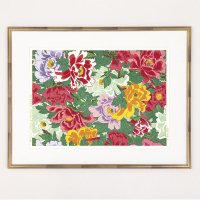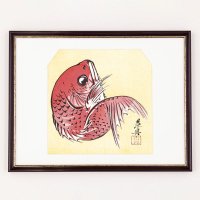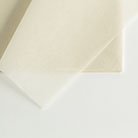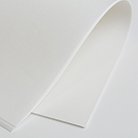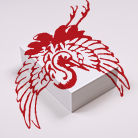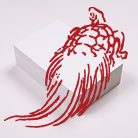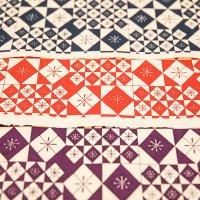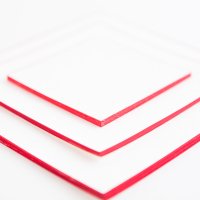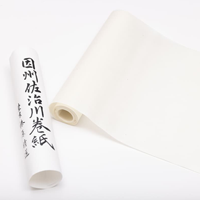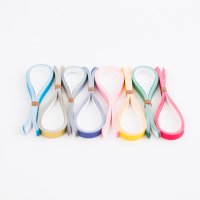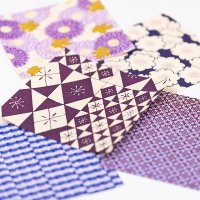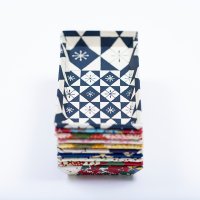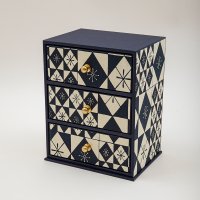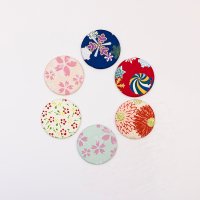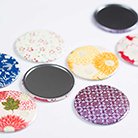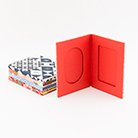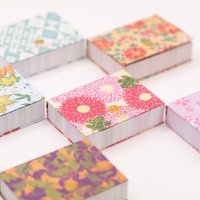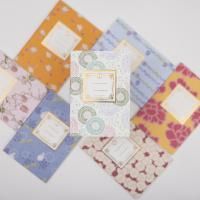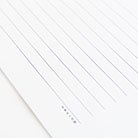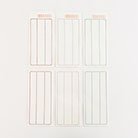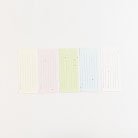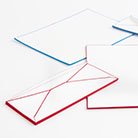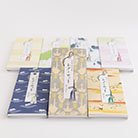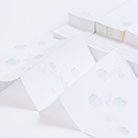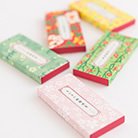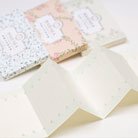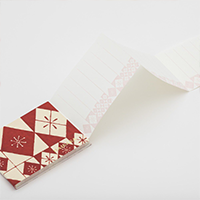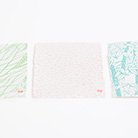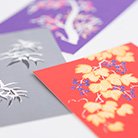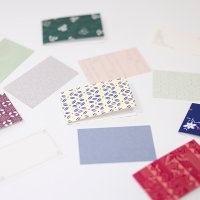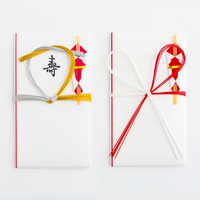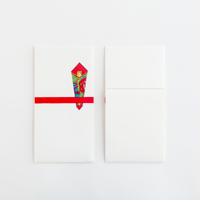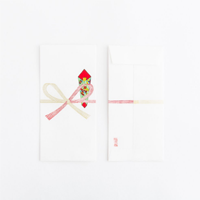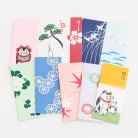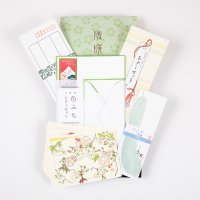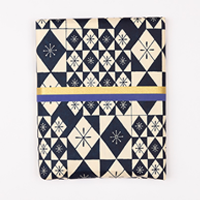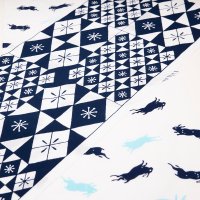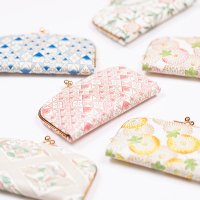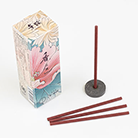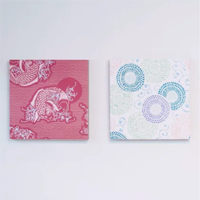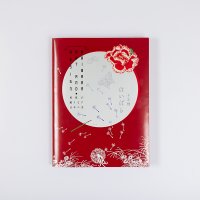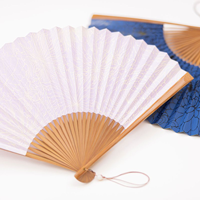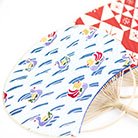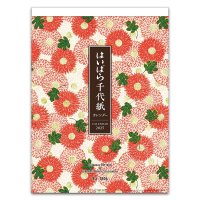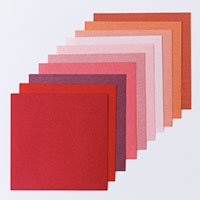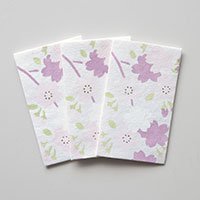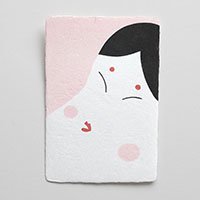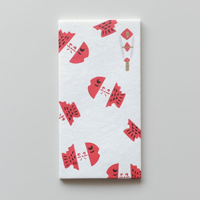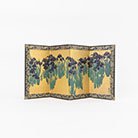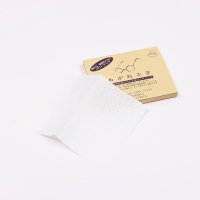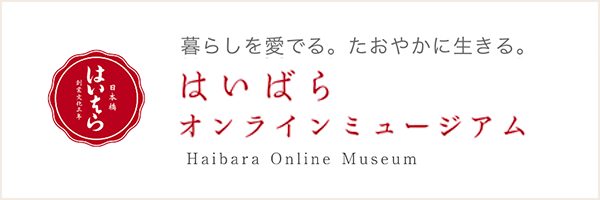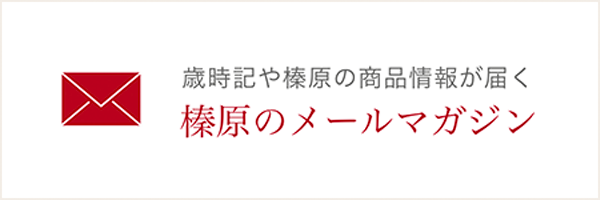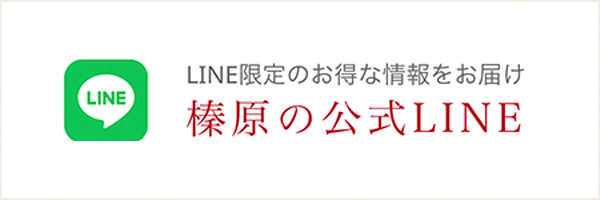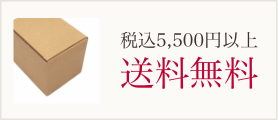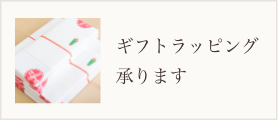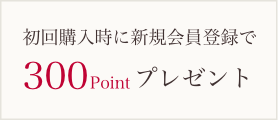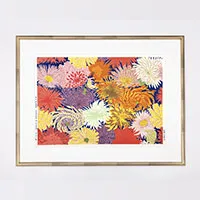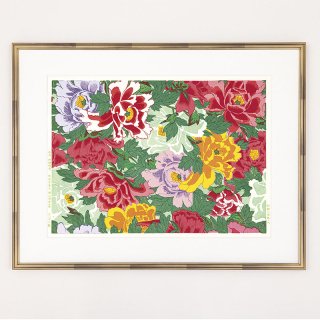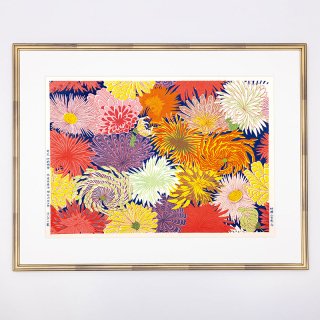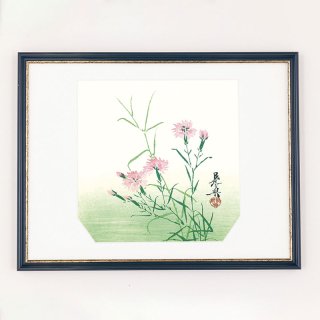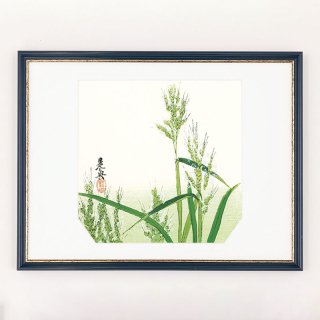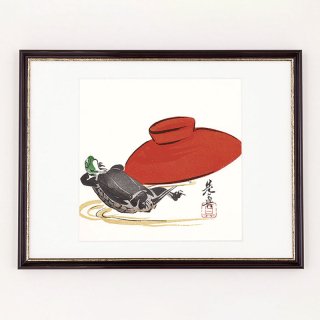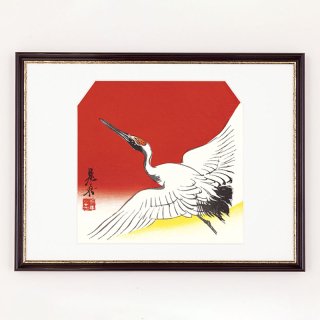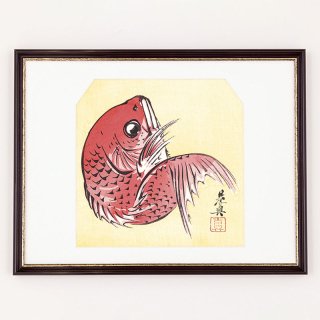- 1-8 / 8
- 1
はいばら木版摺美術画
はいばら木版摺美術画プロジェクトについて
Haibara woodblock print artwork
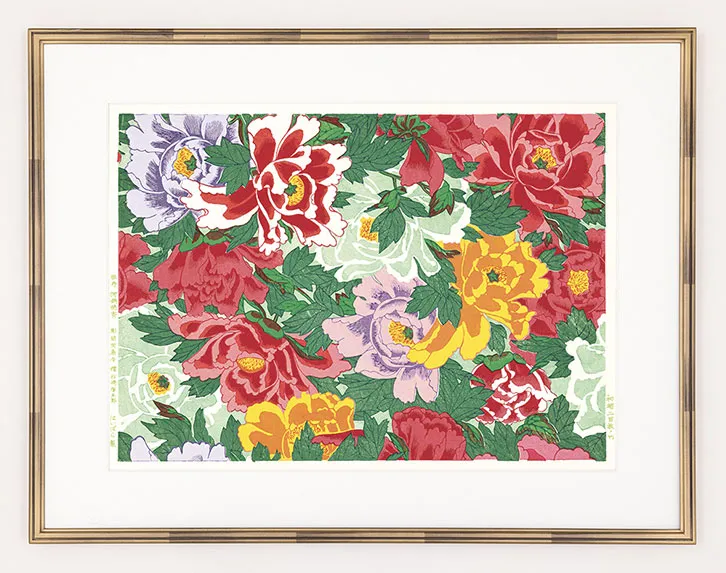
技法は当時と同じ、
彩度は現代に合わせて調整するなど、細部へのこだわりを追求
創業期以来、はいばらは生活を彩り飾る摺り物、襖紙、壁張紙、便箋、封筒などを取り扱ってまいりました。
中でも「はいばらの紅は寿ぎの色」と言われてきたように、
木版摺りの鮮やかな色彩は、人の心に晴れやかな喜びをもたらします。
この度の木版摺美術画プロジェクトを通じ、私たちはもう一度原点に立ち返り、
創業時より江戸の人々にも愛されてきた木版摺りを現代に送り出そうとしています。
当時と同じ技法を用いつつ、彩度も現代に合わせて調整するなど、
細部へのこだわりを追求しました。
Since its founding period, the woodblock printing technique has been an important identity of Haibara.
Since Haibara’s typical items, including the money envelopes and letter papers, are used to represent the feeling of congratulations and compassion, many people were pleased with the vivid colors and deep shades of the woodblock prints.
Through this woodblock print artwork project, we would like to achieve our founding aspirations.
While using the traditional carving and printing techniques, we pursued attention to detail, such as adjusting the color saturation.
はいばら木版摺美術画ができるまで
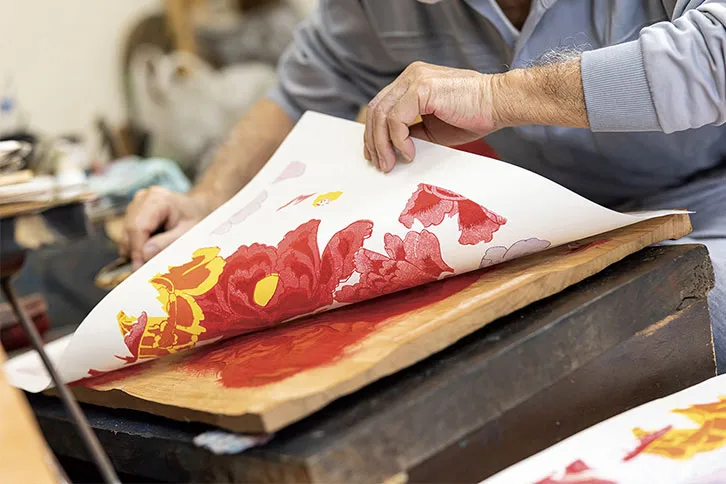
木版画は和紙に版木を用いて一色づつ色を刷り重ねていき仕上げる
完成に至るまでには、紙漉きの職人が木版摺りに適した和紙を漉き上げ、
彫師によって色ごとの版木を彫り分け、摺師が一色ごとに顔料を刷り重ねるといったような、
数々の工程を経て完成いたします。
紙についてAbout washi (Japanese paper)
「越前生漉奉書」と呼ばれる、楮(こうぞ)100%の手漉き和紙を使用
今回の紙は、福井県越前市で作られました。
「越前生漉奉書」と呼ばれる和紙で、楮(こうぞ)100%で手漉きで漉かれます。
楮は他の和紙の原料である雁皮(がんぴ)や三椏(みつまた)よりも太く長い繊維が特徴です。
木版画は一色ごとに版木からバレン※で和紙に色を擦り付ける工程を、何度も重ねて作品に仕上げていきますが、
この柔らかい和紙はバレンで擦り易く、一方で何色も刷りを重ねた後でもさらに色を吸うことができる強さも兼ね備えています。
The paper we use is called “Echizen Kizuki Hosho” , which is produced in Echizen City, Fukui Prefecture, and is made by hand using 100% paper mulberry tree without using wood pulp.
Paper mulberry tree is characterized by thicker and longer fibers than other Japanese paper raw materials such as gampi and mitsumata.
For woodblock prints, the process of rubbing colors from printing block to paper with a printing tool called baren※ is repeated many times.
Soft papers made from paper mulberry are easy to rub with baren, at the same time havinhaving the strength that can withstand overprinting.
越前奉書は最高の木版画用紙としての役割を担ってる
「奉書」とは、戦国時代から権力者が使用してきた公文書用紙のことですが、
越前で産する奉書は日本一と呼ばれ、権力者たちの手厚い庇護を受け紙座と共に繁栄してきました。
武家が居なくなってしまった現在も、越前奉書は最高の木版画用紙としての役割を担っています。
“Hosho” had been used for writing official documents from the Warning State Period (1467~).
Especially, the Hosho produced in Echizen was considered to be the best quality in Japan and had received the generous patronage of authorities.
Even now, Echizen Hosho still plays the role of the best woodblock print paper.

今回の紙は、色を何度も重ねて摺っていく際にも、できるだけ紙の「伸び」が少なくなるように作られたものです。
まず、ふねと呼ばれる水槽に楮(こうぞ)の繊維を満たし、一枚一枚手作業で紙が漉き上げられます。
Filling a vat called Sukibune with paper mulberry fiber mixed with water

漉き上がった和紙は紙床(しと)に伏せてゆきます。
Laying the newly formed sheets of papers on Shito (paper beds)

一般的なサイズである「柾判」の、倍の大きさで漉いています。
これは、摺りでバレンの力が加わった時にも紙伸びしにくい繊維の方向にするためです。
大きなサイズになるため、作業中に破れないよう間に布を挟みながら積み上げます。
Piling up the newly formed sheets of papers

この後、一晩かけ徐々に圧搾をかけ水分を抜き、翌日乾燥工程を迎えます。

乾燥は、一枚一枚丁寧に、しかし力強く銀杏の板に張り付けていきます。
ここで銀杏を使うのは、水に強く年輪が目立たないためです。
今回のように木の板を使うことで、両面からやんわりと乾燥させることができ、より柔らかな肌合いの和紙に仕上げることができます。
Stretching out papers one by one on wooden boards to be dried

板肌の面が紙の表となり、乾燥を終えました。
「越前生漉き奉書」の完成です。
“Echizen Kizuki Hosho” completed
彫りについてAbout carving
ここから、彫りの工程に移ります。
河鍋暁斎シリーズは、彫りを木版彫師 三代目関岡扇令が手掛け、柴田是真シリーズは榛原に古くから伝わる版木を使用しております。
今回版木に使用しているのは「山桜」です。
古くから木版画に使われている木材で、木目が細かく、反りが少ないうえに粘りもあり、加工性の高い素材です。
The woodblock used for this artwork is made from the wild mountain cherry tree.
Wild mountain cherry wood has a fine grain, can minimize bending, and traditionally used for carving and printing.

はいばらに残されている摺り物を元に、かすれ・ゆがみを調整した彫り用の原画を作成。
二層紙に複写したものを版木に貼った状態。
Create a primary drawing for carving and paste a copy on the woodblock
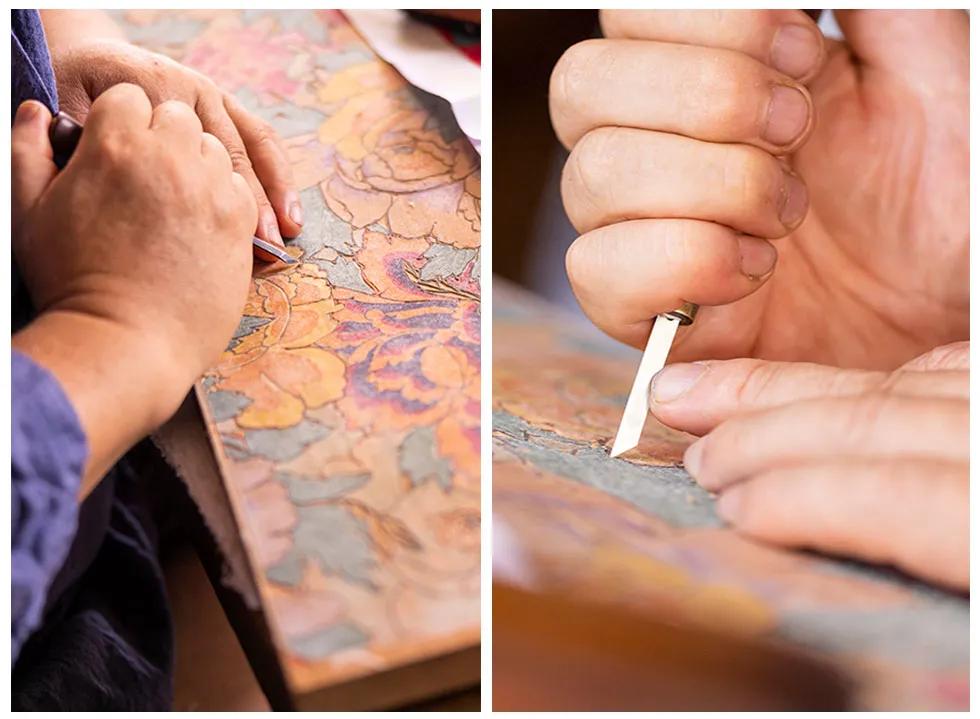
木目の方向があるため正確な線を彫るには4方向から刀を入れる必要があります。
想像以上に手間がかかります。
Carving the woodblock from four sides according to the direction of the grain
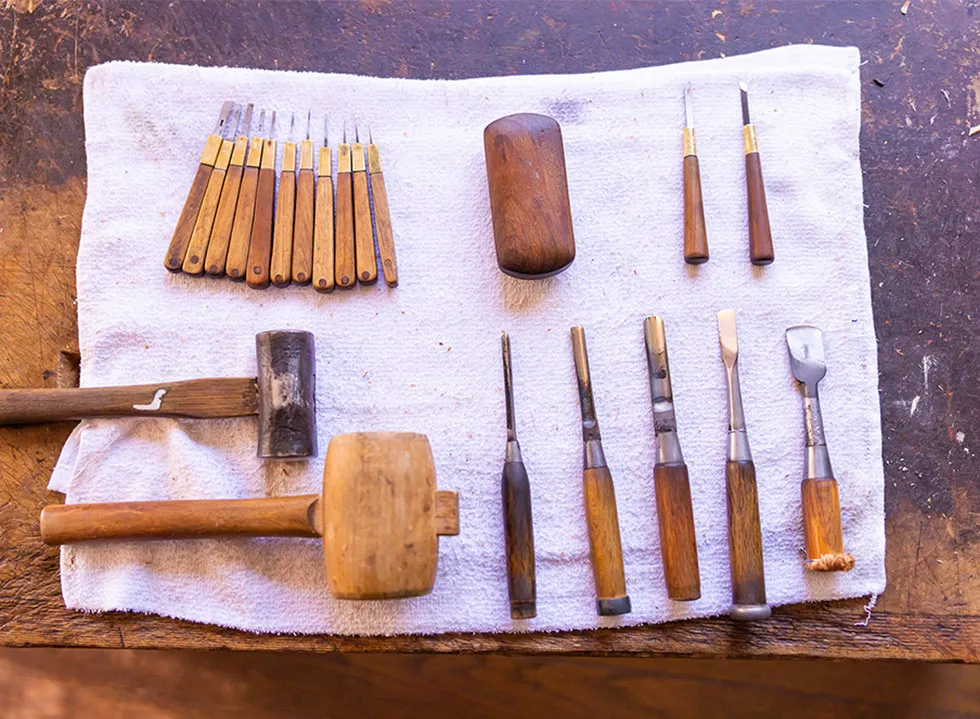
細かい部分・大きい面の部分など刀・ノミを使い分けています。
研ぎ方にもこだわり、持ち手の部分も手にフィットするようカスタマイズしながら使います。
Various tools used for carving
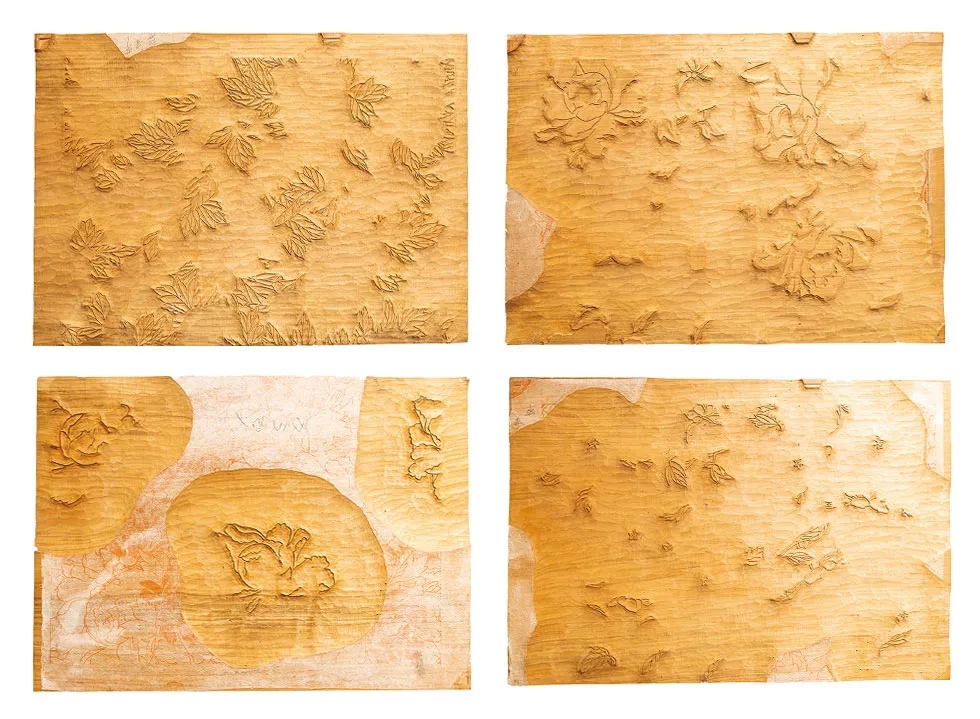
今回の図案は全部で14 色なので、空摺りの図案を含めて15面の板を彫っています。
木材は自然のものだけあって、木の節や油の多いところを考慮しながら、どの版木にどの部分を彫るか決めています。
Since 14 colors and 1 embossment pattern are used for this artwork,15 woodblocks are carved
摺りについてAbout printing
最後に、摺りの工程です。
摺りは2014年春の叙勲で瑞宝単光章を受賞した木版摺師 松崎啓三郎が手掛けました。
バレンと呼ばれる、麻の紐と竹の皮で作られた道具で、紙に顔料を摺っていきます。
Rubbing pad called “baren” , which is made of hemp string and bamboo skin is used to add pigment to paper.

顔料と膠を混ぜたものをハケで版木に塗っていきます。
Spread the pigment mixed with glue on the woodblock using a brush

バレンで紙に摺っていきます。
バレンには様々な太さで撚った麻紐が入っており、版の細かさによって使い分けていきます。Printing the pattern using a rubbing pad “baren”

各版木の位置を確認、試し摺り・微調整を繰り返しながら
本番の摺りに向かいます。
Check the position of each printing and make final adjustments
摺る順番について
14回の色摺りにより作品を完成させていきます。
基本は淡い色から濃い色へと順に摺り、さらに空摺り(エンボス加工)を施して視覚的な印象を深めています。
大きな特徴は「墨版」を用いないこと、つまり構図全体を描き出す黒い輪郭線が本作品にはありません。
本来は、その輪郭線だけの摺りを複製することで、同じ位置にぴたりと重なり合う色版を作ることができ、結果的に精緻な摺り物へと完成します。
ところが今回はその手掛かりがないために、難易度の高い摺りに挑まなければなりませんでした。
加えて、豪華な多色刷りにすればするほど、摺りの位置合わせ自体が技術的に難しくなります。
この厳しい条件下で、摺師の高度な技巧による試行錯誤がなされました。
暁斎時代の配色の意図を最大限に尊重しなら、墨の暗さが抜けた、目にも鮮やかな色調を現代に再現することができました。
